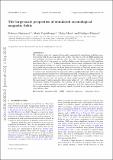The large-scale properties of simulated cosmological magnetic fields
Author(s)
Marinacci, Federico; Vogelsberger, Mark; Mocz, Philip; Pakmor, Rüdiger
DownloadThe large-scale properties.pdf (4.878Mb)
OPEN_ACCESS_POLICY
Open Access Policy
Creative Commons Attribution-Noncommercial-Share Alike
Terms of use
Metadata
Show full item recordAbstract
We perform uniformly sampled large-scale cosmological simulations including magnetic fields with the moving mesh code arepo. We run two sets of MHD simulations: one including adiabatic gas physics only; the other featuring the fiducial feedback model of the Illustris simulation. In the adiabatic case, the magnetic field amplification follows the B ∝ ρ[superscript 2/3] scaling derived from ‘flux-freezing' arguments, with the seed field strength providing an overall normalization factor. At high baryon overdensities the amplification is enhanced by shear flows and turbulence. Feedback physics and the inclusion of radiative cooling change this picture dramatically. In haloes, gas collapses to much larger densities and the magnetic field is amplified strongly and to the same maximum intensity irrespective of the initial seed field of which any memory is lost. At lower densities a dependence on the seed field strength and orientation, which in principle can be used to constrain models of cosmic magnetogenesis, is still present. Inside the most massive haloes magnetic fields reach values of ∼ 10-100 μG, in agreement with galaxy cluster observations. The topology of the field is tangled and gives rise to rotation measure signals in reasonable agreement with the observations. However, the rotation measure signal declines too rapidly towards larger radii as compared to observational data.
Date issued
2015-09Department
MIT Kavli Institute for Astrophysics and Space ResearchJournal
Monthly Notices of the Royal Astronomical Society
Publisher
Oxford University Press
Citation
Marinacci, Federico; Vogelsberger, Mark; Mocz, Philip and Pakmor, Rüdiger. “The Large-Scale Properties of Simulated Cosmological Magnetic Fields.” Monthly Notices of the Royal Astronomical Society 453, no. 4 (September 14, 2015): 4000–4020.
Version: Author's final manuscript
ISSN
0035-8711
1365-2966
